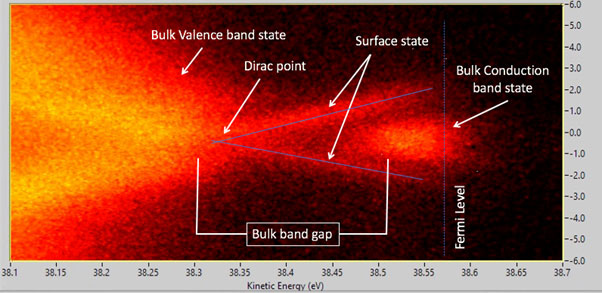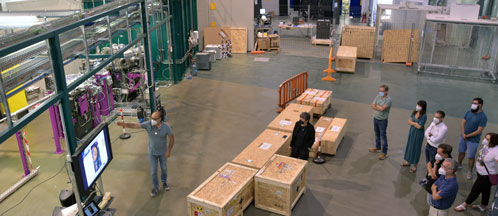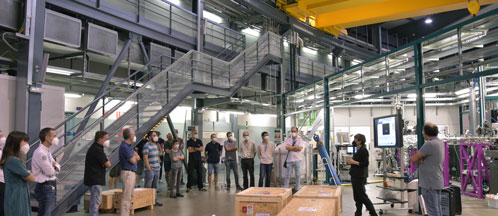
Fig. In the first ARPES image of LOREA, one can see the angular band dispersion of Bi2Te3 in the angular range (-6˚,+6˚) as a function of the kinetic energy of the electrons emitted from the sample exposed to photons with 43eV energy. The bulk valence and conduction bands with a band gap of more than 0.2eV, and the surface state showing a linear angular dispersion, converging towards the "Dirac point" placed about 0.3eV below the Fermi Level. The image was taken using photons with energy of 43eV.
Cerdanyola del Vallès, 6 August 2021. LOREA is the new beamline at ALBA dedicated to the study of quantum materials by means of Angle Resolved PhotoElectron Spectroscopy (ARPES). The ARPES technique is the most powerful to determine the band structure of solids and unveil important characteristics of materials to be used in quantum computing, for low energy consumption microelectronics, for superconductors, photovoltaics, and many other devices using the charge or the spin of electrons to transport, store or convert energy.
LOREA is in the commissioning phase and it is expected to be receiving the first users by October 2021. It will offer both national and international users new tools to discover and modify new materials and new functionalities.
A fundamental step in the commissioning is the generation of the first ARPES measurement, where the photons generated in the storage ring are guided to the experimental station through a complex optical path of focusing mirrors, slits and the monochromator developed at ALBA. In the experimental station the photons meet the sample and produce electrons (photoemitted electrons) which are analysed to determine their energy and momentum distribution inside the material. To be useful, the ARPES technique requires a high-energy and angular resolution, which are available at LOREA.
As a first experiment for the new beamline, the chosen sample was made of bismuth-telluride (Bi2Te3), a thermoelectric material capable of converting electricity into temperature difference and vice-versa. Bismuth telluride is a topological insulator, meaning that it is an insulator (or semiconductor) in its bulk state, but it is highly conductive (almost perfectly conductive, with linear bands to build a "Dirac cone") on its surface alone, through the formation of surface states which are resistant to contamination.
"We are very happy of the performance of the beamline, which will make LOREA one of the best ARPES beamlines to investigate quantum materials", says Massimo Tallarida, LOREA's beamline responsible.
The next steps of commissioning continue in the following weeks with the optimization of the energy resolution and increase of the photon flux.
Monochromator made in-house
The soft X-ray beamlines require monochromators having several gratings and mirrors positioned with high mechanical accuracy. The experience cumulated at the Engineering division of the ALBA Synchrotron over the years allowed to face the challenge of designing and building an ultra high vacuum monochromator in-house, including new design concepts.
The large energy range of LOREA (10-1000 eV) requires a device with three mirrors and four gratings with variable line spacing to reduce optical aberrations. The mirrors are located along the beam path and have vertical and incidence angle degrees of freedom whereas the four gratings are placed transversally and the operating one is selected with a linear guide transversal to the beam direction. The mirrors and operating gratings are water cooled to cope with the power of the beam.
The most important part of the monochromator, the grating system, has been carefully designed to be insensitive to external disturbances such as vibrations from the cooling water and at the same time to have very high mechanical performances.
The most innovative part, in turn, is the cooling system of the gratings for evacuating the power load density from the absorbed X-rays of 1 W/mm2. It has no vacuum guards or double piping, which are well-known sources of failures. The heat load is removed through copper straps in contact with a temperature controller device connected to fixed water lines. With this, the precise motion of the grating is unaffected and the transient temperature drifts, due to the opening of the beamline front end or a change of grating, are minimized. In addition, the operating temperature can be kept fixed for different power loads thanks to the temperature controller.
"Designing and building the LOREA monochromator has been very challenging. It is always complicated when new ideas are developed. We are proud to see that the instrument is ready to work with great technical performances", says Alejandro Crisol Ariño, team manager of LOREA optical and mechanical components.


Snapshots from the event held last 21 July 2021 to present the good results of the LOREA commissioning. Massimo Tallarida summarised the outcome of the commissioning to a reduced number of people involved in the project.
The project is co-funded by the European Regional Development Fund (ERDF) within the Framework of the ERDF Operative Programme of Catalonia 2014-2020.






